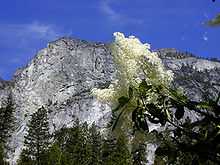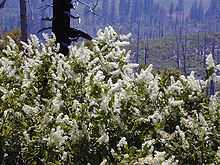Ceanothus integerrimus
| Ceanothus integerrimus | |
|---|---|
 | |
| Scientific classification | |
| Kingdom: | Plantae |
| (unranked): | Angiosperms |
| (unranked): | Eudicots |
| (unranked): | Rosids |
| Order: | Rosales |
| Family: | Rhamnaceae |
| Genus: | Ceanothus |
| Species: | C. integerrimus |
| Binomial name | |
| Ceanothus integerrimus Hook. & Arn. | |
Ceanothus integerrimus (deer brush) is a woody shrub in the family Rhamnaceae, native to the western United States, in Arizona, New Mexico, California, Oregon, and Washington. It grows in montane chaparral and woodlands regions, in hardwood forests, and in fir, spruce, and Ponderosa pine plant communities, being most abundant in the California chaparral and woodlands and Sierra Nevada.[1][2]
Description
Ceanothus integerrimus is a deciduous shrub from 1–4 metres (3.3–13.1 ft) tall with an open ascending to erect branch habit.[2] It is a drought-tolerant phanerophyte. Nitrogen-fixing actinomycete bacteria form root nodules on Ceanothus roots.[3][4] Its stems are round yellow to pale green in color with either small soft to straight stiff sharp hairs parallel to or in contact with the surface of the stem,.[2][5]
The leaves are glossy, deciduous and 2.5–8 cm long. Leaves grow alternately on stems. The leaf petioles are less than 15 mm in length and the stipules are also deciduous. The leaf blade is lanceolate, elliptical or oblong to widely ovate in shape. Leaves can have one to two ribs from the base; they are also generally thin and have an acute to obtuse tip. Leaf margins are either entire or slightly dentate, more so towards the leaf tip. Leaf surfaces are light green and are ciliate or contain hairs visible only by magnification. The lower leaves are also hairy and lighter in color.[2]
The flowers are white or blue and rarely pink in color. They are produced in raceme clusters of 15 centimeters or less and contain both male and female organs. The fruit is a sticky valved capsule about 4–5 mm in diameter with a slight crest; the seed is ejected from the capsule after splitting.[2]
It regenerates by seed, shoot formation from the crown and stem, and also by layering when branches come in contact with soil.[4][6] It has been suggested that some Ceanothus species do not resprout from the root after the crown has burned as a result of fire where most other species are able to regenerate.[7] Pollination of flowers is primarily by bees.
Seed production occurs after about four years of age. High densities of seeds occur in the upper soil of Ceanothus communities. Seeds remain viable up to 24 years or more. Seed dormancy is broken by the removal of the seed coat by fire scarification or physical disturbance.[4][6] Seeds germinate best at about 1 inch soil depth in shady areas in the spring following fire scarification.[4][6]
Varieties
There are four weakly defined varieties of Ceanothus integerrimus. Identification is primarily by leaf morphology and flower color:[2][4][6]
- Ceanothus integerrimus var. californicus.[8] Leaves elliptic, lanceolate or oblong to ovate in shape and are three ribbed, from the leaf base. Leaf surfaces have small hairs and the undersides are less hairy than the surface. Flowers generally white or blue.
- Ceanothus integerrimus var. integerrimus.
- Ceanothus integerrimus var. macrothyrsus.[9] Leaf blades oblong or ovate. Leaf bases are three ribbed at the base. Leaf surfaces are pubescent on both the surface and undersides. Flowers are white.
- Ceanothus integerrimus var. puberulus.[10] Leaf blades elliptical or lanceolate and oblong to obovate in shape. Leaf base is three ribbed from the leaf base. Leaves are also pubescent on both sides. Flowers white.
Ceanothus integerrimus hybridizes with Ceanothus tomentosus (Lemmon's ceanothus) and Ceanothus cordulatus (mountain whitethorn).
Ecology

C. integerrimus is an important part of forest regeneration after wildfires by providing nitrogen.[11] It does this by creating nitrogen rich patches in the soil. The nitrogen source is created by its root association with nitrogen fixing bacteria.[1]
Deer and specifically mule deer feed on C. integerrimus. Porcupines and quail have also been observed eating the stems and seeds.[12] Nutritionally leaves are a good source of protein and stems and leaves also contain high levels of calcium. However, nutritional quality of leaves is seasonal and appears to be best from fall to early spring.[4]
Uses
Indigenous peoples of California use the branches to treat women after childbirth.[13] The Miwok Indians of Northern California also use the branches of this plant in weaving complex baskets.[4] The Concow tribe call the tree hē′-bē (Konkow language).[14]
References
- ↑ 1.0 1.1 [Oakley]
- ↑ 2.0 2.1 2.2 2.3 2.4 2.5 [Jepson]
- ↑ [Gibbens]
- ↑ 4.0 4.1 4.2 4.3 4.4 4.5 4.6 [Howard]
- ↑ [Munz]
- ↑ 6.0 6.1 6.2 6.3 [Griffin]
- ↑ [Raven]
- ↑ (Kellogg) Benson
- ↑ (Torrey) Benson
- ↑ (Greene) Abrams
- ↑ [Debano]
- ↑ [Russell]
- ↑ [Moerman]
- ↑ Chesnut, Victor King (1902). Plants used by the Indians of Mendocino County, California. Government Printing Office. p. 404. Retrieved 24 August 2012.
Bibliography
- Debano, L. F. & Conrad, C. E. (1978). The Effect of Fire on Nutrients in the Chaparral Ecosystem. Ecology 59 (3): 489-497.
- Gibbens, R. R. P. & Schultz, A. M. (1963). Brush manipulation on a deer winter range. California Fish and Game 49 (2): 95-118. [5976].
- Griffin, James R. (1982). Pine seedlings, native ground cover, and Lolium multiflorum on Marble-Cone burn, Santa Lucia Range, CA. Madrono 29 (3): 177-188.
- Jepson Flora Treatment: Ceanothus integerrimus
- Howard, Janet L. (1997). System Ceanothus integerrimus In: Fire Effects Information [Online]. U.S. Department of Agriculture, Forest Service, Rocky Mountain Research Station, Fire Sciences Laboratory. .
- Munz, P. A. & Keck, D. D. (1959). A California Flora with Supplement p. 973. University of California Press, Berkely, Los Angeles.
- Moerman, D. Native American Ethnobotany. Timber Press, Oregon: 1988.
- Oakley B. B., North, M. P., & Franklin, J. F. (2003). The effects of fire on soil nitrogen associated with patches of the actinorhizal shrub Ceanothus cordulatus. Plant and Soil 254: 35-46.
- Oswald, V. H. & Ahart, L. (1994). Manual of the Vascular Plants of Butte County, California p. 192. Native Plant Society, Sacramento.
- Raven, P. H. & Axelrod, D. I. (1977). Origin and relationships of the California Flora. University of California Publications in Botany 72. Sacramento: University of California Press.
- Russell, C. P. (1932). Seasonal Migration of Mule Deer. Ecological Monographs 2:1 pp. 1–46.
External links
| Wikimedia Commons has media related to Ceanothus integerrimus. |
- USDA Plant Profiles: Ceanothus integerrimus
- Jepson Interchange - Ceanothus integerrimus
- 'Ceanothus integerrimus' - Photo Gallery